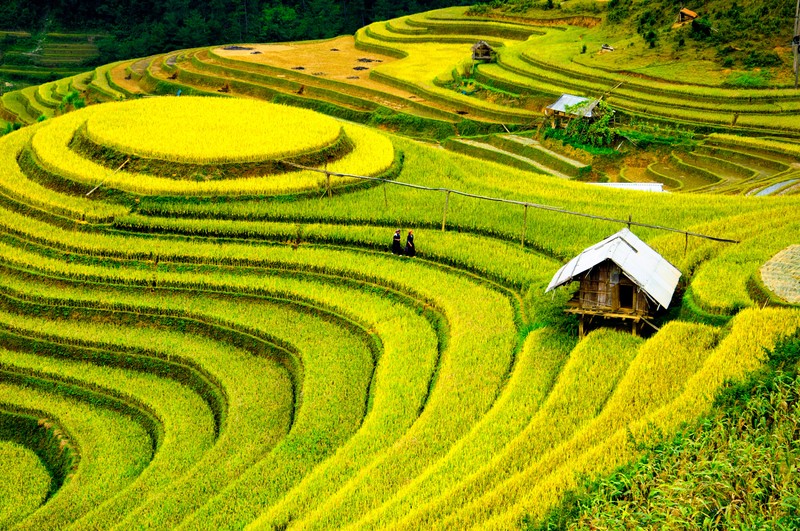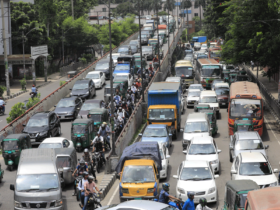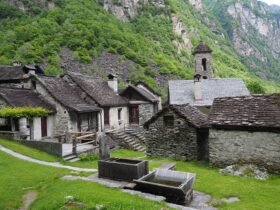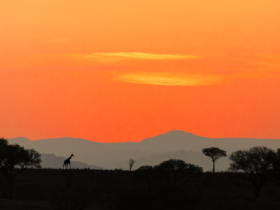Vietnam’s rice fields represent its culture and agriculture. These fields, usually terraced, cross the undulating terrain, producing a magnificent patchwork that captivates everyone. In luxuriant growing season, these fields are vibrant green, but in harvest season, the golden tones of matured rice provide joy and prosperity.
Poets, painters, and travellers have long been inspired by these vistas, which balance nature and human activity. A complex agricultural system that combines technology and traditional hand harvesting displays locals’ dedication to environmental protection and their way of life. Rice fields in Vietnam agricultural heritage.
Terraced Fields: Nature’s Masterpiece
Vietnam’s terraced rice fields in Sapa and Mu Cang Chai are renowned. Terraces built into mountainsides give a magnificent staircase-like impression. Beautiful green rice plants on each terrace highlight local farmers’ hard work. Terraces have been used for generations to increase arable land and minimize soil erosion. Their engineering excels.
The elaborate design enhances tropical rice cultivation and underlines local inhabitants’ close relationship with their environment. Each crop layer gets water, giving a sustainable solution for difficult terrain. These stunning landscapes attract visitors and photographers from throughout the world as symbols of perseverance and legacy. These terraces show how ancient agricultural techniques may survive with nature while keeping ecological balance, balancing human inventiveness with nature’s obstacles.
Rice festivals and cultivation strengthen community relationships and highlight rice’s importance in Vietnamese culture. Vietnam’s rice farming history has changed, and this beautiful agricultural environment is a bittersweet reminder of that connection and part of its character.
Seasonal Transformations: A Visual Feast
Vietnam’s rice fields alter substantially seasonally. April rice planting occurs in newly flooded regions. Summer crops thrive in the heat, while autumn fields are covered with golden rice ready for harvest. Fresh colors, textures, and fragrances make each season a visual feast for visitors and residents. This yearly cycle showcases the agricultural rhythm that maintains rural communities and beauty.
Wildlife Habitat: Biodiversity and Ecosystem
Vietnamese rice fields are varied ecosystems that sustain more than crops. Waterlogged fields provided wetlands for birds, amphibians, and insects. Many rice farmers maintain fish, ducks, and other animals near their fields to boost biodiversity. Farming and nature maintain the environment’s delicate balance and enhance land yield. Thus, rice fields feed and shelter animals, exhibiting sustainable farming.
Sustainable Practices: Balancing Tradition and Modernity
The rice fields of Vietnam demonstrate the necessity for sustainable agriculture in the face of climate change and food security. Many farmers utilize integrated pest control and organic farming to lessen their environmental effect and yield massively. These methods improve agriculture and save water and soil. Vietnam’s rice fields use traditional and contemporary methods for sustainable agriculture.
Tourist Experiences: Immersing in Rural Life
Traveling to Vietnam’s rice fields lets you meet locals and experience rural life. In beautiful settings, guided excursions educate tourists about local agriculture and customs. Vietnamese cuisine often uses farm-fresh products. Holiday’s help people remember rice farming and understand its cultural importance.
Conclusion
Rice fields are part of Vietnam’s culture and legacy, not only agriculture. Vietnamese people revere these natural beauties, which are worldwide assets for their beauty, ecological significance, and cultural richness. Visitors may appreciate these beautiful landscapes and learn about Vietnam’s cultures and history. Every grain of rice symbolizes life, past, and future.







